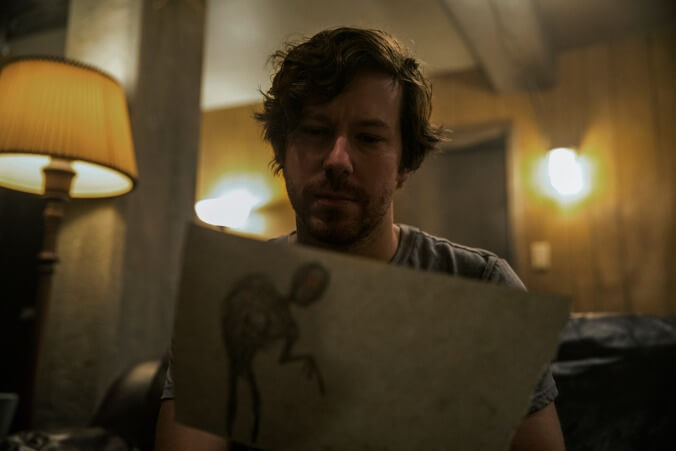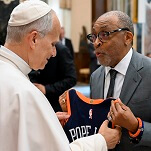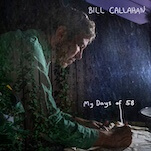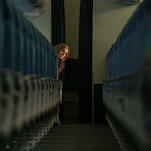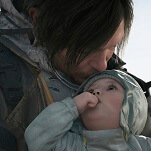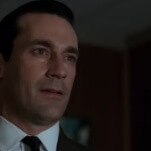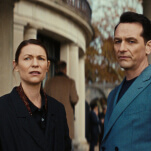is an Amblin entertainment in the purest, classic sense. It recalls an era when the name of Steven Spielberg’s production company in the credits all but guaranteed his involvement, or at least some distilled version of his lucrative pop sensibilities. Whether the master of the summer blockbuster ever so much as skimmed the treatment for this derivative (but sometimes fiendishly effective) supernatural thriller, the impression of his style is as clear as a dripping handprint on a chilled window pane. It’s Spielbergian in giddy craftsmanship, in the sentimentality of its broken-home family drama, and in the way it opens a portal of wonder and terror into the American suburbs—much like one of the first and finest of Spielberg mentorships,
. Hell, the film even arranges a visual callback to the
immortalized in the Amblin logo. This time, though, there’s nothing heartwarming about the sight of a Michelangelo finger tap between boy and gangly, inhuman “friend.”
The first whiff of the Jaws director’s savvy gusts in right at the start, with the informative economy of Come Play’s opening minutes. Awoken in the middle of the night, a small boy creeps downstairs for a drink of water; a peek into the other bedroom introduces one sleeping parent, while the other slumbers on the couch—instant visual clues of the home’s domestic discord. Nearly as quickly, we’re clued that the boy, eight-year-old Oliver (Azhy Robertson, already an old pro at playing the son of divorcing parents), is somewhere on the autism spectrum. He’s mostly non-verbal, communicating through a smart-phone app that reads aloud whatever he types; when overwhelmed, he retreats to the glow of a device and the comfort of SpongeBob SquarePants reruns.
Oliver’s parents, Sarah (Gillian Jacobs) and Marty (John Gallagher Jr.), aren’t always perfect at recognizing and meeting their kid’s needs. It’s implied that one of the things straining their unraveling marriage is shared guilt about a failure to recognize sooner that their son might have developmental disabilities. Those tensions at home, combined with Oliver’s loneliness as a child ostracized by his classmates, opens a window of opportunity for Larry, a towering beanstalk of a creature fishing for a new companion who first appears on the boy’s phone in the form of a creepy digital fairy tale. Larry is an eBook Babadook, come to claim the child of a frazzled and soon-to-be-single mother.
Writer-director Jacob Chase, making his feature debut, expanded Come Play from an inventive short film. The result is involving, but a little pat as drama; you see the strings, even when it’s successfully pulling the ones attached to your heart. As a horror movie, though, it’s often diabolical fun: a PG-13 funhouse ride of peekaboo jolts. Beyond restaging the inspiration’s basic scenario (Oliver’s dad works as a nighttime attendant in an unnervingly empty parking lot), Chase builds on the short’s tricks of distance, flickering illumination, and tablet-camera perspective. Devices become devices for generating fear; running down a Chekhovian checklist, the film keeps introducing some new gizmo—Oliver’s word-playback program, a facial recognition filter, an app that tells you how close someone is standing—and exploiting it for a shivery-good scare. Chase also knows how to extend a take to ratchet up the suspense, allowing our eyes to adjust to some nifty unwelcome surprise in the frame, like stray papers blown onto the invisible body of a monster inching closer and closer to whoever conjured him.
This isn’t the first horror movie to treat an autistic character as the catalyst, or maybe even a conduit, for otherworldly menace. The Darkness, which felt similarly (though less productively) indebted to Poltergeist, got there a few years ago. On the challenges of raising Oliver, the film may be as well-meaning but imperfect as Sarah and Marty: The vague sense that Larry is a monster powered by gadget addiction (screens are windows that he hopes to turn into doors into our world) doesn’t entirely square with an understanding of how essential modern technology may prove for a kid who needs a little extra help communicating. But Chase also seems earnestly rather than mechanically invested in the day-to-day obstacles facing this family. It helps that Sarah is played by Gillian Jacobs, in a rare dramatic role; she has a special affinity for characters sincere in their intentions and sympathetic in their failures at realizing them.
The real star, of course, is Larry. Part CGI bogeyman, part sophisticated puppet (Jim Henson’s Creature Shop designed his on-set incarnation), he’s delightfully unnerving in his height and lurching, unfolding movements. The film doesn’t wear out his welcome, either. In another nod to Spielberg, Chase mostly keeps Larry off screen, implied or half-glimpsed, until the climax of chases and evasions that recall, faintly but unmistakably, the hide-and-seek delights of Jurassic Park, down to the seamless alternation of digital and practical effects. This is a movie with Spielberg in its veins, regardless of how much influence he directly asserted; by the end, when Come Play is aiming to break as many hearts as it palpitates, a viewer may feel like they’ve been jerked back to the Amblin heyday of families besieged by wonders of Hollywood imagination—at least until the ghost-town half-emptiness of the theater shatters the illusion.
